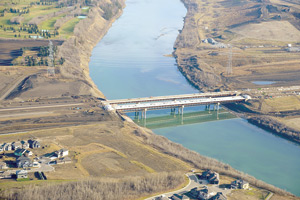P3s Are Popular Funding Method in Canada; US DOT Takes Steps to Promote Option

While nine public-private partnerships for transportation had their financial closing in Canada in 2015, only three such infrastructure projects did the same in the United States, whose population is nine times as large.
One reason for that discrepancy is that Canada has P3 agencies on the federal, provincial and municipal levels, while the United States does not.
In 2014, the U.S. House Transportation and Infrastructure Committee’s special panel on public-private partnerships recommended lowering barriers to the federal government entering into P3 agreements and called for creating a Transportation Procurement Office in the Department of Transportation while continuing the Transportation Infrastructure Finance and Innovation Act program.
“Billions of dollars of infrastructure needs in the U.S. are in search of funding, and well-executed public-private partnerships can enhance the delivery and management of infrastructure,” panel chairman Rep. John Duncan Jr. (R-Tenn.) said then.
However, such failed P3 projects as the Indiana Toll Road, which filed for bankruptcy in 2014 after the 2008 recession caused it to fail to meet its traffic projections, caused some pullback in the United States.
Darrin Roth, vice president of highway policy for American Trucking Associations, said ATA almost always opposes P3s because they usually lead to the installation of tolls.
“We’ve had this increasing reliance on P3s because of the lack of revenue from traditional means, but it’s a less efficient way of funding highway projects than simply with revenue from fuel taxes or registration fees,” Roth said.
Transport Canada said that the nation devoted 4% of its gross domestic product to transportation in 2013, while the United States hit a two-decade low of just 1.7%, according to the Federal Reserve Bank of St. Louis. That same year, the American Society of Civil Engineers gave U.S. roads a “D” grade and estimated that more than $100 billion annually of investment was needed through 2028 to restore them to good shape.
Texas recently opened a P3, the LBJ Freeway in downtown Dallas, which has a cantilevered second deck to accommodate the managed lane. But even Texas, with its wide-open spaces and private-sector bent, is cautious about P3s.
“We’ve had mixed levels of success with P3s,” said Robert Nichols, chairman of the Texas Senate’s Transportation Committee. “I think the LBJ Freeway is going to be a success, [but] the general consensus from the Legislature is that we need to kind of hold off and see how these work for a while. The Legislature has to approve P3 projects, and right now, the votes aren’t there to approve any new ones.”
That could change with the establishment in September of the Build America Transportation Investment Center within the Department on Transportation. BATIC was created to serve as a one-stop shop to help states and municipalities navigate the search for private investment for infrastructure projects.
“We’re making progress,” said Jodie Misiak, BATIC’s project development director, who previously helped spearhead Maryland’s controversial Purple Line transit project. “In Maryland, there was less debate about whether the Purple Line was a P3 than whether the project fit the policy needs of the state. Once people see successful P3 projects, they’re going to say, ‘I want one of those.’ ”
Misiak cited Virginia as a P3 leader because of such projects as the Capital Beltway’s HOT lanes and the Dulles Corridor Metrorail extension.
And yet Pierce Homer, who oversaw both of those when he was Virginia’s secretary of transportation, said, “It’s very difficult to repair and replace existing infrastructure and then put a toll [which private developers want to repay their investment] on it. You need large traffic volume and room to add capacity and a toll.
“If you want to do a managed lane, you need capacity, but where the volumes are, real estate tends to be extremely dear,” he said. “In Virginia, we were able to squeeze in two additional lanes in each direction mostly within the existing right of way.”
Canada’s P3 experience dates to the 1990s and the construction of the Confederation Bridge between the provinces of New Brunswick and Prince Edward Island.
The federal Canadian P3 agency, which is just 7 years old, funds up to 25% of the capital costs for projects on the provincial and local levels and plays an advisory role to the specific federal agency that’s responsible for a project. Among those is Infrastructure Canada, which is building the tolled replacement for the 50-year-old, toll-less Champlain Bridge, which carries 160,000 vehicles a day across the St. Lawrence River in Montreal.
In Canada, any public works project that costs at least $100 million and is projected to last at least 20 years must be considered for P3 financing. That helps turn more Canadian projects into P3s, even though all toll revenue belongs to the governmental agency in charge.
However, because the United States has tax-exempt municipal debt — which Canada doesn’t — that pushes more American projects toward solely public financing.
“In the U.S., we don’t really have a consistent formal process of deciding which financial strategy to use,” said Standard & Poor’s Trevor d’Olier-Lees. “There’s a lot of muddiness in the decision-making process. You need leadership because you don’t have process.”
Bill Reinhardt, editor of the Public Works Financing newsletter, said Canada’s steady deal flow and mostly standardized contracts, compared with the state-by-state nature of public works in the United States, helps more P3s get done north of the border.
And because Canadian projects don’t get canceled or changed at the last minute, as has happened in the United States, “the world’s largest, most sophisticated and financially strong P3 developers compete very aggressively for Canadian projects,” Reinhardt said. “We’re nowhere near Canada in our ability to create a sustainable deal flow of projects, which is what everybody wants.”

